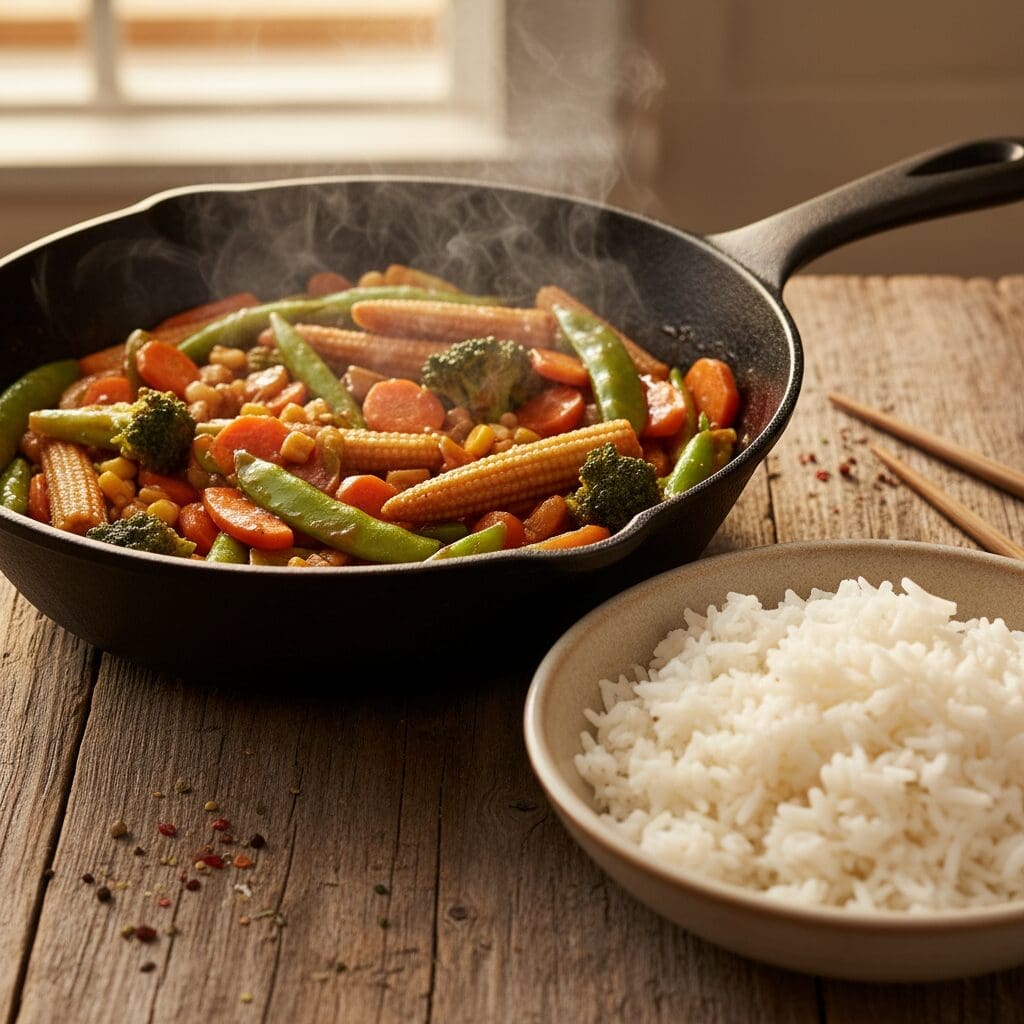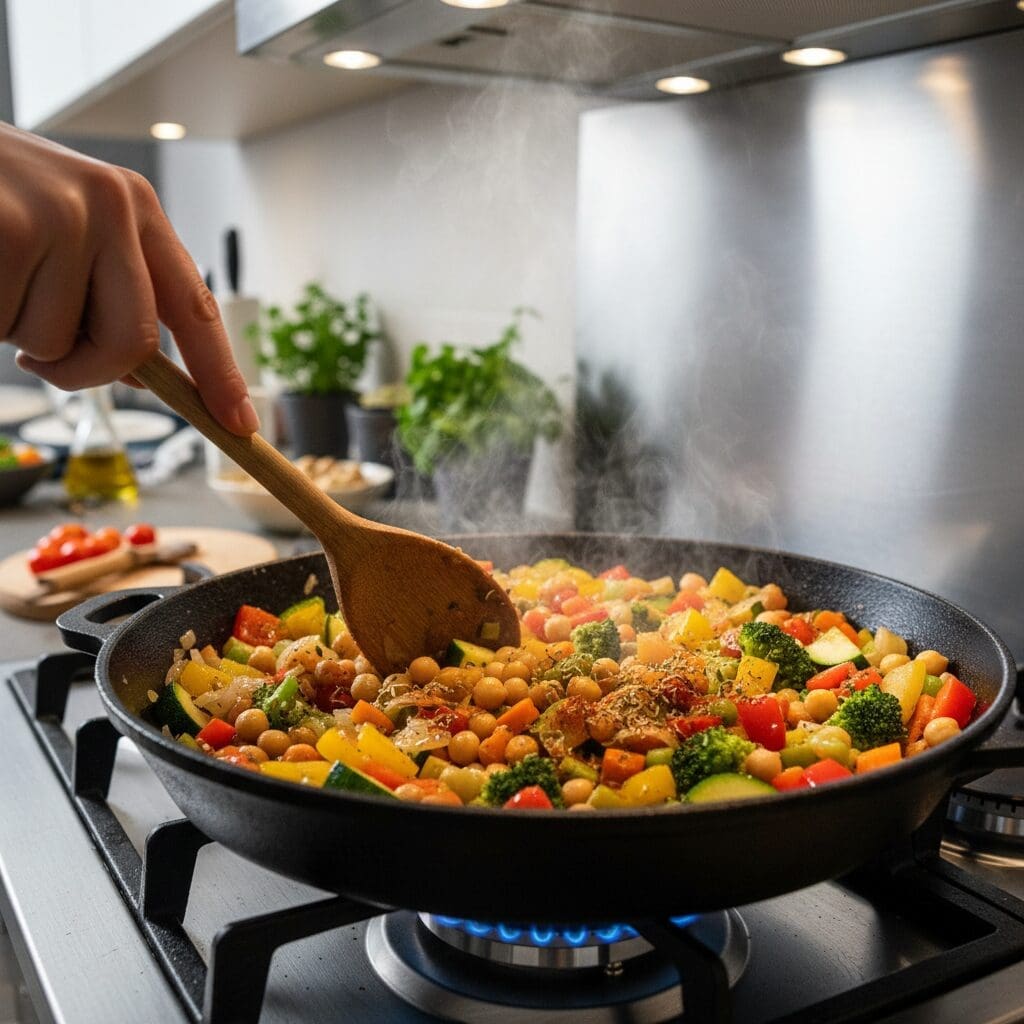Easy One-Pot Vegan Biryani Recipe (Ready in 30 Minutes!)

If you’re a fan of Indian takeout but want a healthier, quicker option at home, this Easy One-Pot Vegan Biryani is your new go-to. Imagine fluffy basmati rice infused with warm garam masala, turmeric, and cumin, mingled with colorful vegetables and hearty chickpeas – all cooked together in a single pot for minimal cleanup.
This recipe skips the traditional multi-step process of marinating and layering, yet captures the essence of authentic biryani’s depth of flavor. Whether you’re vegan, vegetarian, or just looking to cut back on meat, this dish is satisfying, nutritious, and beginner-friendly.
In just 30 minutes of active cooking time, you’ll have a fragrant feast that rivals your favorite restaurant. Let’s dive into why this version works so well and how to make it your own.
What Makes This Vegan Biryani So Special?

Biryani hails from South Asia, particularly popular in India, Pakistan, and beyond, where it’s celebrated for its layered flavors of spiced rice, aromatics, and proteins. Traditionally, it involves parboiling rice, frying onions to caramelized perfection, and sometimes slow-cooking with yogurt-marinated meat.
But this vegan twist streamlines everything into one pot, making it accessible for busy weeknights. What sets this recipe apart?
It’s not just the simplicity – it’s the balance of textures and tastes. Crunchy veggies like cauliflower and green beans contrast with soft potatoes and plump raisins for subtle sweetness.
The spice blend – garam masala for warmth, turmeric for earthiness, and a hint of cayenne for kick – builds complexity without overwhelming. Plus, as a plant-based dish, it aligns with sustainable eating trends.
According to the World Health Organization, vegan meals like this can lower heart disease risk by reducing saturated fats. It’s flavorful takeout nostalgia, reimagined for modern kitchens.
Key Ingredients and Smart Substitutions

This recipe shines with everyday ingredients that pack a punch. Start with 2 cups of basmati rice – its long grains stay fluffy and separate, absorbing flavors without getting mushy.
Aromatics like 1 medium onion (sliced thin), 1 tablespoon minced ginger, and 5 cloves garlic form the flavor base; they’re essential for that authentic depth. The veggie medley includes 1 carrot (sliced diagonally for even cooking), 1 Yukon gold potato (chopped small for tenderness), 1 cup cauliflower florets, 1/2 cup each frozen peas and green beans, and a 15-oz can of chickpeas (drained) for protein. If you have extra, this quick curry chickpea salad makes for a fantastic lunch.
Optional 1/2 cup raisins add a sweet contrast. Spices are non-negotiable: 2 tsp garam masala, 1/2 tsp turmeric (which is anti-inflammatory, per a 2017 study in the journal Foods), 1 tsp each coriander and cumin, 1/4 tsp cayenne, 1/2 tsp cinnamon, plus salt and pepper.
Finish with 4 cups vegetable broth for richness. Substitutions?
Use jasmine rice if basmati’s unavailable, but rinse well to avoid stickiness. Swap potatoes for sweet potatoes for extra nutrition, or add bell peppers for color.
For gluten-free, ensure your broth is certified. These tweaks keep it flexible while maintaining the dish’s integrity.
Step-by-Step Instructions

Prep time: 20 minutes | Cook time: 30 minutes | Total: 50 minutes | Servings: 8
Ingredients:
- 2 tbsp olive oil
- 1 medium red or yellow onion, thinly sliced
- 1 tbsp minced fresh ginger
- 5 cloves garlic, minced
- 1/4 cup water
- 1 medium carrot, peeled and sliced diagonally
- 1 Yukon gold potato, peeled and chopped small
- 1 cup cauliflower florets
- 1/2 cup frozen green peas
- 1/2 cup frozen green beans
- 15 oz can chickpeas, drained and rinsed
- 1/2 cup raisins (optional)
- 2 tsp garam masala
- 1/2 tsp ground turmeric
- 1 tsp ground coriander
- 1 tsp ground cumin
- 1/4 tsp cayenne pepper
- 1/2 tsp ground cinnamon
- 1 1/2 tsp salt
- 1/2 tsp black pepper
- 4 cups vegetable broth
- 2 cups basmati rice, rinsed
Instructions:
- Prep everything: Chop veggies, drain chickpeas, and measure spices. Rinse rice until the water runs clear.
- Heat 2 tbsp olive oil in a large skillet or Dutch oven over medium-high heat. Add the onion and sauté for 5 minutes until translucent, stirring often.
- Stir in the ginger and garlic; cook for 1 minute until fragrant.
- Add 1/4 cup of water to deglaze the pot, then toss in the carrot, potato, cauliflower, peas, green beans, chickpeas, and raisins (if using). Stir for 2 minutes.
- Add all spices, salt, and pepper. Stir to coat the veggies evenly and cook for 1-2 minutes to bloom the flavors.
- Pour in the vegetable broth and add the rinsed rice. Stir once and bring to a boil.
- Cover, reduce heat to medium-low, and simmer for 15-20 minutes until the rice is tender and the liquid has been absorbed.
- Remove from heat and fluff with a fork. Re-cover and let it rest for 5 minutes.
- Garnish with fresh cilantro and toasted almonds. Serve hot!
Nutrition (per serving): 278 kcal, 52g carbs, 7g protein, 5g fat, 4g fiber.
Expert Tips for Perfect Biryani Every Time

As a seasoned vegan recipe developer, I’ve tested this biryani multiple times to ensure foolproof results. First, rinsing the rice is crucial – it removes excess starch, preventing a gummy texture. If your rice still turns out sticky, next time use a bit more broth (up to 4.5 cups) or cook uncovered for the last 5 minutes to evaporate extra moisture.
For deeper flavor, bloom your spices: Sauté them briefly after adding to the veggies, as heat activates their oils.
Don’t skip the rest after cooking; it lets steam redistribute for even fluffiness. If veggies seem underdone, chop them smaller or add frozen ones later to avoid overcooking.
Pro tip: For authentic flair without extra effort, infuse broth with a cinnamon stick or bay leaf during simmering. And if scaling down for fewer servings, halve everything but keep the rest time the same.
These tweaks elevate your home cooking from good to restaurant-worthy.
Common Questions and Troubleshooting

Can I make this in a rice cooker? Yes! Sauté aromatics in a pan first, then transfer everything to the cooker with the broth and rice. Use the ‘mixed’ or ‘white rice’ setting.
Why is my biryani bland? Check your spices – they should be fresh. Taste and adjust salt before adding the rice; a pinch more garam masala after cooking can revive it.
Is this recipe gluten-free or nut-free? It’s naturally gluten-free. For a nut-free version, simply omit the almonds or use sunflower seeds for a similar crunch.
Can I use brown rice? It works, but it increases the cook time to 40-45 minutes and may require more liquid. For the best results, stick to white basmati rice.
How do I fix mushy rice? This is usually caused by over-stirring or insufficient rinsing. Next time, handle the rice gently and measure your broth precisely.
These answers come from real kitchen trials, ensuring you succeed on your first try.
Serving Suggestions and Pairings

Elevate your biryani with simple sides. A cooling vegan raita – made with coconut yogurt, cucumber, and mint – balances the spices perfectly.
Scoop it up with warm vegan naan bread, perfect for sopping up every flavorful bite. For a full Indian-inspired meal, pair with a hearty vegan lentil soup, creamy tikka masala, or roasted curried cauliflower.
These combos create a feast in under an hour. Serve family-style in the pot for a communal vibe, or portion into bowls for meal prep.
It’s versatile enough for potlucks too – just reheat gently with a splash of broth.
Storage, Freezing, and Meal Prep

This biryani is meal-prep gold! Leftovers keep in an airtight container in the fridge for up to 5 days.
Reheat in the microwave with a damp paper towel over it (1-2 minutes) or on the stovetop with 1-2 tbsp of broth to restore moisture. For freezing, portion into freezer bags where it will last for 2-3 months.
Thaw overnight in the fridge, then reheat as above. Avoid repeated freezing to maintain texture.
Pro tip: Add fresh cilantro and almonds only after reheating for that just-made crunch. With 8 servings, it’s ideal for batch cooking – save time and enjoy vegan comfort food all week.
Conclusion
This Easy One-Pot Vegan Biryani proves that bold flavors don’t require hours in the kitchen. It’s a testament to how simple swaps and smart techniques can deliver restaurant-quality results at home.
Whether you’re new to Indian cuisine or a vegan veteran, this recipe invites experimentation while staying true to its roots. Whip it up tonight and transport your taste buds to South Asia – your weeknight dinners just got a whole lot more exciting!
